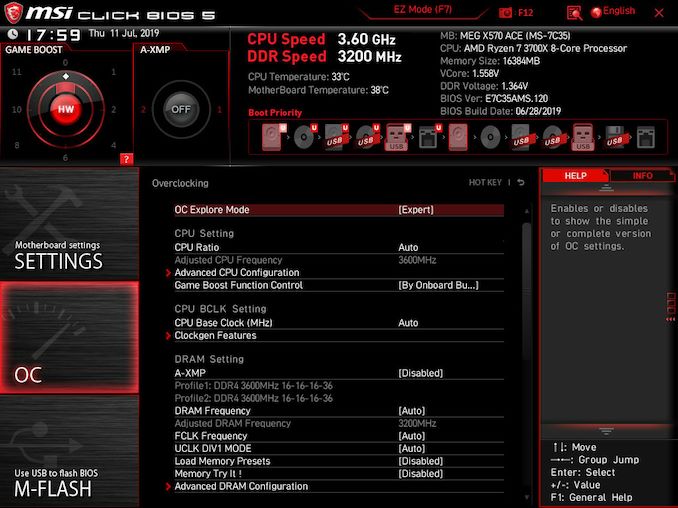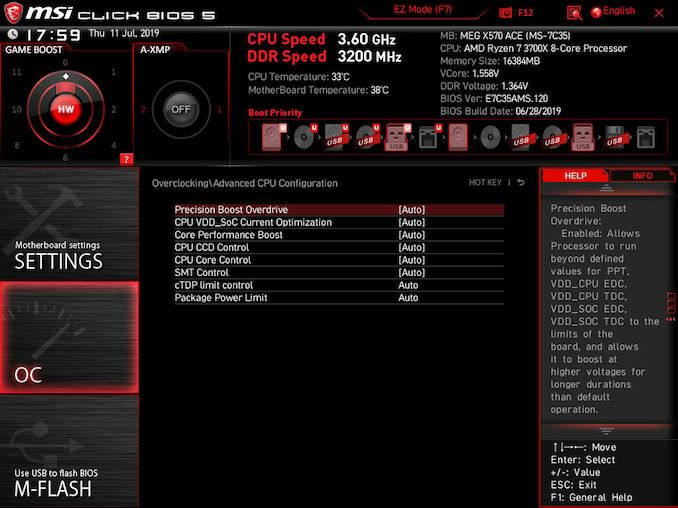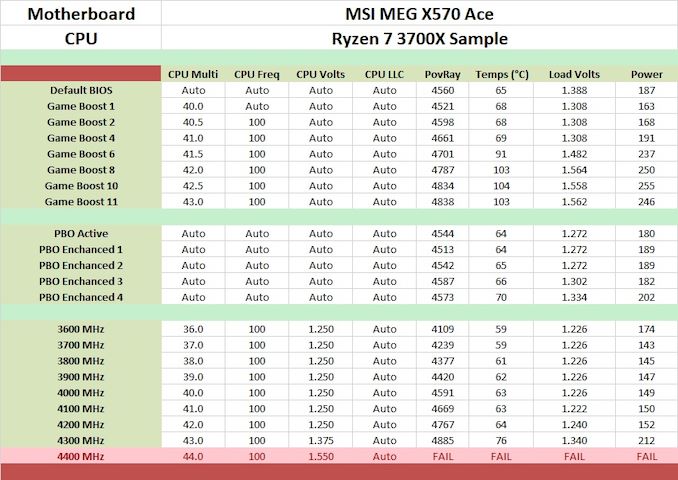The MSI MEG X570 Ace Motherboard Review: Ace in the Hole at $369
by Gavin Bonshor on July 18, 2019 11:00 AM EST- Posted in
- Motherboards
- AMD
- MSI
- AM4
- Zen 2
- Ryzen 3000
- X570
- MEG
- X570 Ace
- 3700X
- Ryzen 3700X
Overclocking Ryzen 3000
Experience with the MSI MEG X570 Ace
It's no secret that the general consensus of overclocking with the Ryzen 3000 series has been so far disappointing. Whether it be the limitations of the new 7 nm silicon or the insane temperatures that these processors run at when overclocked, or even at stock settings with the stock cooler, to unlock the full potential of these chips, better cooling methods such as premium AIOs and custom water cooling is needed.
Overclocking with the MSI MEG X570 Ace motherboard, there are three ways this can be achieved; within the firmware, with the simple, albeit effective tools inside the MSI Dragon Center application or with the comprehensive AMD Ryzen Master overclocking software. For the purpose of this review, we used the MSI Click BIOS 5 firmware which is very intuitive to use, and although this model was quite laggy, it still worked without issues. While the most commonly changed settings to overclock the processor include the CPU ratio which increases the frequency in increments of 100 MHz and the CPU VCore which increases the voltage pumped into the processor which not only generates extra heat but also increases power consumption.
In addition to the boost feature of the Ryzen 3000 processors, another AMD specific feature is called Precision Boost Overdrive or PBO. The three main variables that PBO works from including package power tracking (PPT), thermal design current (TDC), and the electrical design current (EDC). All three of these can be set within the firmware under the advanced section of the Precision Boost Overdrive menu, although MSI has included four different PBO profiles for users to select from. In addition to these are seven different Game Boost CPU overclocking profiles with each profile ranging from 4.0 GHz all cores up to 4.3 GHz all cores; these go up in increments of 50 MHz.
Overclocking Methodology
Our standard overclocking methodology is as follows. We select the automatic overclock options and test for stability with POV-Ray and OCCT to simulate high-end workloads. These stability tests aim to catch any immediate causes for memory or CPU errors.
For manual overclocks, based on the information gathered from the previous testing, starts off at a nominal voltage and CPU multiplier, and the multiplier is increased until the stability tests are failed. The CPU voltage is increased gradually until the stability tests are passed, and the process repeated until the motherboard reduces the multiplier automatically (due to safety protocol) or the CPU temperature reaches a stupidly high level (105ºC+). Our test bed is not in a case, which should push overclocks higher with fresher (cooler) air.
Overclocking Results
The 12+2 power delivery of the MSI MEG X570 Ace is one of the best we have seen from MSI in recent years and as a result, allowed us to manually overclock our Ryzen 7 3700X sample to 4.3 GHz with a set voltage of 1.375 V. Using the default load line calibration setting, this resulted in a load CPU VCore of 1.340 V which gives us a VDroop of 0.035 V in total. Of course, this can be alleviated by using a more aggressive LLC profile, but for the purposes of our testing, we leave this setting at auto. More voltage pumped into the CPU not only results in higher operating temperatures, but this also increases the overall power consumption.
Testing out each of MSI's seven Game Boost profiles did yield some interesting findings. First of all, each profile overvolted our Ryzen 3700X by a massive margin when you factor in what we achieved by using manual settings. Secondly, the three highest Game Boost profiles pumped insane amounts of CPU VCore in which in turn, made our 240mm AIO closed-loop cooler go into overdrive with temperatures in the triple digits. Outside of extreme overclocking, no Ryzen 3000 processor should be subjected to voltages of 1.562 V for a 4.3 GHz overclock on ambient cooling. Performance however was consistently higher with each of the profiles in our POV-Ray benchmark and by default with the Game Boost profiles, thermal throttling is disabled meaning that there is a trade-off between heat and performance. We also tested with PBO and found that performance was actually worse than the default settings, with MSI's four PBO profiles not really having much of an effect on performance; this leads us to believe for the most part, that PBO on Ryzen 3000 could do with a rework to make it more effective.













92 Comments
View All Comments
Sparkyman215 - Thursday, July 18, 2019 - link
Why are certain seemingly random portions of the article specifically tagged a certain color? The body <p> tags are #444 but some snippets are set to rgb(68,68,68) (which is #444) in the same <p> tag. I know it literally doesn't matter to anyone but I noticed it and it's weird hahayeeeeman - Thursday, July 18, 2019 - link
Dear Anandtech, not everyone needs PCIe 4.0 and these gimmicky motherboards. Also, not everyone has over 200$ to throw, so please test all new Ryzens on B350 motherboards.Showtime - Thursday, July 18, 2019 - link
Yeah pricing is high IMO. I want to go AMD, but I can't justify spending $200 on motherboard for a $200 CPU. Some people have had to do some work to get the older, cheaper motherboards to work right after the bios update. Guess I'll wait and see. Not like my old Intel is slow.Holliday75 - Thursday, July 18, 2019 - link
I am of the opinion that unless you plan on buying a new PC in the next several years after putting a 3000 based system together then spend the money and get the x570 based board. There are cheaper models to choose from, but the PCI 4.0 support will be very nice to have down the road when GPU's are taking advantage of it. Having to upgrade a motherboard mid-ownership cycle would suck and eat up any savings you and then some by using a lower end board.If you already have one it looks like it works on most boards and the performance drop off is not that bad. In IT you pay now or pay later, but you always pay. I prefer up front to avoid it down the road when it tends to be more of a pain in the arse.
Irata - Friday, July 19, 2019 - link
Definitely agree with your comment.My plan is to get a good X570 mainboard now and use it with a Ryzen 3700x. Once the Ryzen 3000 series is EOL, I want to upgrade to a 3950x which hopefully can be had cheaper then.
Looking at the reviews of PCIe 4 NVMe that are available right now, I see little point in getting one now, but will definitely upgrade to one once Samsung and others offer them.
All of this I would like without having to replace the motherboard.
shabby - Thursday, July 18, 2019 - link
The 3900x works even on a320 boards but only hits around 3.7ghz tops. I honestly don't think these $300+ boards with trick vrm/phases are needed at all, these ryzen chips peak at 4.3ghz with liquid cooling. Even $200 boards should easily 16 cores at that speed.Targon - Thursday, July 18, 2019 - link
The cost of PCI Express 4.0 is the reason for the high motherboard prices. You do get what you pay for when it comes to motherboards.29a - Thursday, July 18, 2019 - link
I almost always buy a super cheap Asrock or Biostar motherboard and never have any issues with speed or stability.pavag - Saturday, July 20, 2019 - link
Maybe those motherboards are prepared for future processors, which need more power.29a - Thursday, July 18, 2019 - link
I agree I came here just to request reviews of cheap motherboards. Also an article addressing all the BIOS settings and detailed explanations on what they do on modern motherboards would be awesome too.